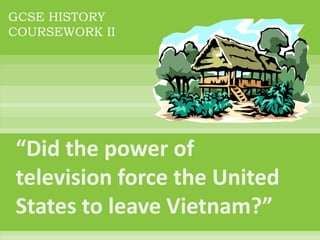
Nam presentation
- 2. The Vietcong quickly learned that anything visible from the air soon became a target – so they looked beneath their feet. Viet Cong bases were built in extensive underground bunkers. These were complex tunnel systems that stretched for over 300km under the forests of Vietnam. The Viet Cong used their intimate knowledge of the jungles to wait for the American GIs and ambush them. The idea of Guerrilla warfare was to never face the Americans head on – but to ambush them and then disappear into the jungle. The Viet Cong often left booby traps ranging from simple pits with „Punji sticks‟ in, to crossbows and explosives. The idea was to make the cost in US lives too high for the US to keep fighting.
- 3. As well as launching attacks in helicopters from their bases in the jungle. The US also used bombers to help out the ground troops. In February 1964 the US air force launched „Operation Rolling Thunder‟. This was an enormous bombing campaign that intended to bomb Vietnam “back into the stone age”. For the next eight years, giant B-52 bombers poured high explosive, napalm (burning petrol jelly) and cluster bombs onto North Vietnam. They also dropped chemicals to destroy the jungle (Agent Orange) that affected the Vietnamese peasants. On June 8, 1972 a South Vietnamese aircraft accidentally dropped its napalm payload on the village of Trang Bang. With her clothes on fire, 9 year old Phan Thi Kim Phuc ran out of the village with her family to be airlifted to hospital. This photo quickly made front page news world-wide, with LIFE magazine giving it full cover page exposure.
- 4. To the young inexperienced GIs it was impossible to tell the difference between an enemy soldier and an innocent civilian. As a result they were often treated the same. On the 5th of August 1965, CBS evening news showed a GI setting fire to the straw roof of a peasant‟s house with his Zippo cigarette lighter. At the beginning of 1968 the American people were told that the Viet Cong were on the brink of collapse. Then the Viet Cong launched a massive attack. It was called the Tet offensive and hit more than 100 locations. People in America questioned how an army on the brink of collapse could organise such an attack and even capture the US Embassy in Saigon. The US army began to use „body count‟ to show they were winning . At My Lai around 400 civilians were killed by GIs including women and children. When the incident became public knowledge in 1969, it prompted widespread outrage around the world. The massacre also reduced U.S. support at home for the Vietnam War.
- 5. Vietnam was the first television war. The American people were served up a nightly diet of death and destruction on the evening news. In Vietnam reporters were allowed to move with the troops and film whatever they wished! During the Tet That evening offensive, US the execution camera crews was witnessed filmed the Chief by 20 million of the south Americans on Vietnamese the news. police, General Nguyen Ngoc People Loan, holding a questioned if pistol to a they were on captive‟s head. the side of good. Loan pulled the trigger and killed the captive.
- 6. By 1968, 300 Americans were dying every week in the war. Eventually reaching a total of over 500,000. The War cost $30,000 million by 1968. preventing promised reforms in the US taking place. LBJ had promised the voters, amongst other things, “to feed…and shelter the homeless”. Moral cost – Killing civilians. Using Napalm which left victims with horrible burns. Toxic chemicals were poisoning people.
- 7. On May 4, l970 members of the Ohio National Guard fired into a crowd of Kent State University demonstrators, killing four and wounding nine Kent State students. The impact of the shootings was dramatic. The event triggered a nationwide student strike that forced hundreds of colleges and universities to close. This affected US policy towards Vietnam. Most Americans in the 50s and 60s had supported the war as they had lived through World War II and wanted to keep America safe. After the war there was a „baby boom‟ and some 30 million babies were born. Most of these were about 20 when the war in Vietnam was taking place and saw the world differently to their parents. “Hell no, we won‟t go!” became their slogan and up and down America people began to protest about conscription. Despite it being a minority of Americans President Johnson was known to be devastated by chants of “Hey, hey, LBJ! How many kids did you kill today?”
